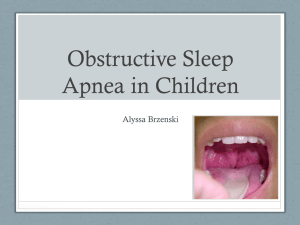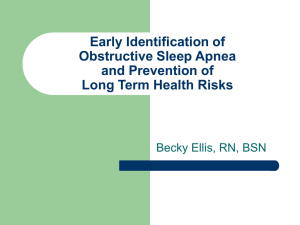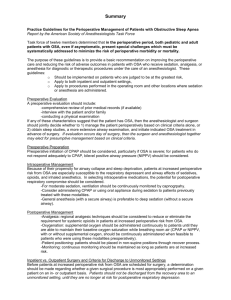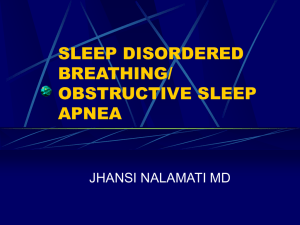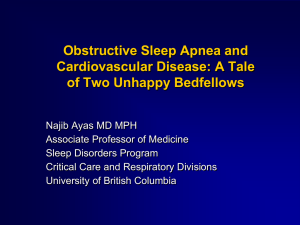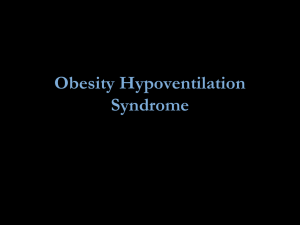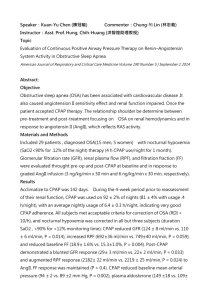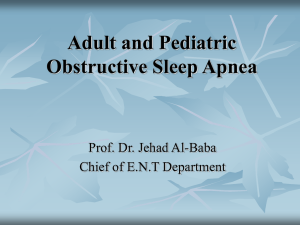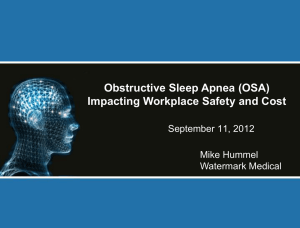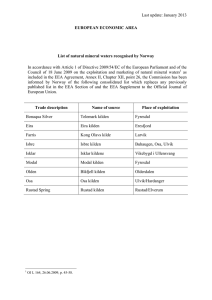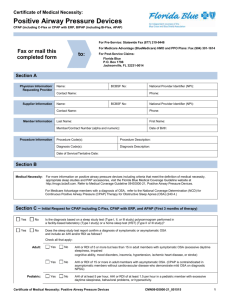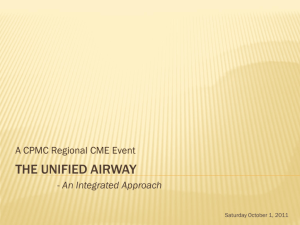Diapozitiv 1
advertisement
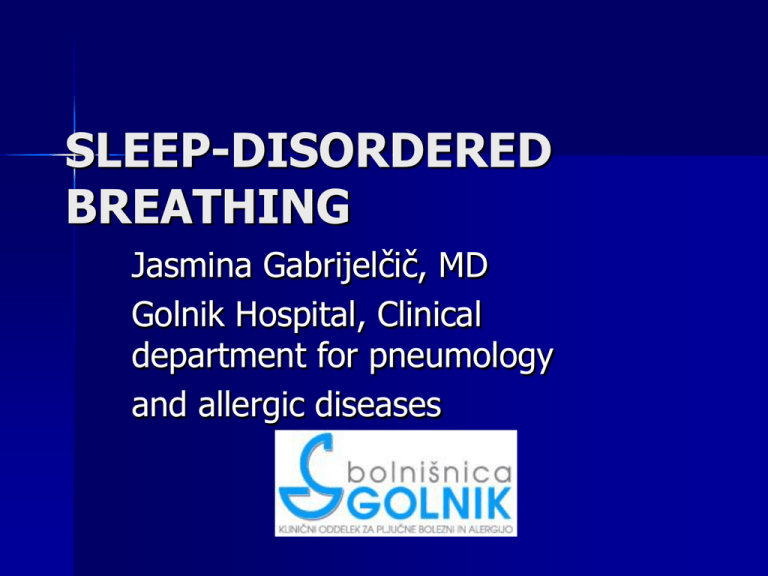
SLEEP-DISORDERED BREATHING Jasmina Gabrijelčič, MD Golnik Hospital, Clinical department for pneumology and allergic diseases HISTORY C. Dickens: The Posthumous Papers of the Pickwick Club; Joe, the fat boy 1965, Gastaut et al (Etude polygraphique des manifestations episodique-hypnique et respiratoirsdiurnes et nocturnes, du syndrome de Pickwick) 1969- first tracheostomy performed 1980- first use of CPAP Apnea: cessation of airflow > 10 sec in adults and > 8 sec in children. Hypopnea: partial (30- 50%) reduction of airflow, or less- if desaturation (<90%) or arousal (EEG) is observed, lasting > 10 s RERA: episodes of decreased inspiratory airflow and increased respiratory effort, which culminate in an EEG arousal, and do not meet the definition of either apnea/hypopnea MIXED APNEA Initial absence of both airflow and ventilatory effort, followed by evidence of a return of effort but a continued lack of airflow RDI-respiratory disturbance index Combined total number of apneas, hypopneas, respiratory effort-related arousals occuring per hour of sleep OSA-obstructive sleep apnea Mild OSA: 5-15 RDI/h of sleep Moderate OSA: 15-30 RDI/h of sleep Severe OSA: > 30 RDI/h sleep Increasing upper airway resistance CONTINUUM: FROM SYMPTOMS TO DISEASE: SNORING UPPER AIRWAY RESISTANCE SYNDROME (UARS) OBSTRUCTIVE SLEEP APNEA OBSTRUCTIVE SLEEP APNEA/HYPOPNEA SYNDROME DEFINITION Repetitive episodes of upper airway obstruction that occur during sleep, usually associated with a reduction in blood oxygen saturation and associated features of daytime sleepiness and snoring. CLINICAL PRESENTATION COMMON REASONS FOR REFERRAL: – Excessive daytime sleepiness – Loud snoring and/or apnea observed by bed partner LESS COMMON REASONS FOR REFERRAL: – – – – – – Nocturnal/early morning headaches Enuresis Gastroesophageal reflux Impotence “seizures” at night Psychiatric disorders PREVALENCE Estimated to be minimaly 2% in general population (4% in men); higher in elderly. RISK FACTORS OBESITY- especially central type; if BMI > 29, then OSA 9-12 times more likely. – NECK CIRCUMFERENCE MALE GENDER- androgenic patterns of body fat distribution favor fat deposition in the neck area; ACROMEGALY HYPOTHYROIDISM STRUCTURAL CRANIOFACIAL ABNORMALITIES CONGESTIVE HEART FAILURE (cause or consequence?) ALCOHOL AND DRUGS PATHOPHYSIOLOGY Recurrent closure of the pharyngeal airway during sleep (velopharynx in 80%). Increased collapsibilty can be due to: LOCAL INFLUENCES: Decreased muscle activity during sleep, Local pharyngeal sensory neuropathy due to snoring vibration trauma, Elevated positive surrounding pressure, Special anatomical abnormalities. CENTRAL INFLUENCES: Reduced ventilatory motor output IMAGING DIAGNOSIS GOLD STANDARD: In-laboratory Polysomnography (PSG), including: measurement of airflow (nasal and oral prongs), measurement of respiratory effort (impedance, inductive pletysmography), oximetry, EEG, EOG, EMG (chin), ECG, snoring (microphones). EXAMPLE OF A PSG CONSEQUENCES OF OSA REPETITIVE INTERMITTENT HYPOXIA CONSEQUENCES OF OSA Mood, neurocongnitive and behavioral effects Systemic hypertension Ischemic heart disease and arrhythmias Cerebrovascular disease Pulmonary artery hypertension CORRELATION: OSA and POLYMETABOLIC SYNDROME? Signs of increased atherosclerosis in OSA Measurements of structural/functional changes: pulse wave velocity (PWV), intima media thickness (IMT) Measurements of increased oxidative stress, increased inflammation, vascular smooth cell activation (VEGF), platelet activation… OSA is an independent risk factor for atherosclerosis progression CONSEQUENCES OF OSA 4 times increased risk of systemic hypertension 2 times increased risk of myocardial infarction and stroke MANAGEMENT Sleep hygiene, including weight reduction Oral (dental) appliances Positive pressure therapy- CPAP Surgical management MANAGEMENT-mechanisms Raising pharyngeal pressure above Pclose (CPAP) Changing the tube law of the passive pharynx (oral appliances) Increasing pharyngeal muscle tone (avoidance of alcohol, hypnotics) ORAL APPLIANCES CHIN STRAP MANDIBULAR REPOSITIONING APPLIANCES TONGUE REPOSITIONING APPLIANCES INDICATED IN SNORING/MILD OSA OR IN MODERATE OSA WHEN OTHER THERAPIES FAILED SURGICAL MANAGEMENT UVULOPALATOPHARYNGOPLASTY (UPPP) MAXILLOMANDIBULAR ADVANCEMENT TRACHEOSTOMY PARTIAL OSTEOTOMY (MANDIBLE, MAXILLA) ONLY IN SELECTED PATIENTS OR WHEN CPAP THERAPY FAILED Continuous positive airway pressure-CPAP System consists of a blower unit that generates and directs airflow downstream to the patient and of a mask (nasal, combined, oral). Fixed pressure CPAP, AutosetCPAP, Cflex CPAP, BiPAP First line therapy for moderate/heavy OSA. CPAP therapy was shown to be effective in reversing all structural/inflammation abnormalities in OSA patients CPAP OSA OSA + CPAP CPAP 0 cm H2O 15 cm H2O Example:before CPAP Example: with CPAP RISK FACTORS OBESITY- especially central type; if BMI > 29, then OSA 9-12 times more likely. – NECK CIRCUMFERENCE MALE GENDER- androgenic patterns of body fat distribution favor fat deposition in the neck area; ACROMEGALY HYPOTHYROIDISM STRUCTURAL CRANIOFACIAL ABNORMALITIES CONGESTIVE HEART FAILURE (cause or consequence?) ALCOHOL AND DRUGS 2 TYPES OF OSA PATIENTS? PATHOPHYSIOLOGY Recurrent closure of the pharyngeal airway during sleep (velopharynx in 80%). Increased collapsibilty can be due to: LOCAL INFLUENCES: Decreased muscle activity during sleep, Local pharyngeal sensory neuropathy due to snoring vibration trauma, Elevated positive surrounding pressure, Special anatomical abnormalities. CENTRAL INFLUENCES: Reduced ventilatory motor output IMAGING DIAGNOSIS GOLD STANDARD: In-laboratory Polysomnography (PSG), including: measurement of airflow (nasal and oral prongs), measurement of respiratory effort (impedance, inductive pletysmography), oximetry, EEG, EOG, EMG (chin), ECG, snoring (microphones).
